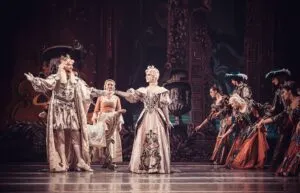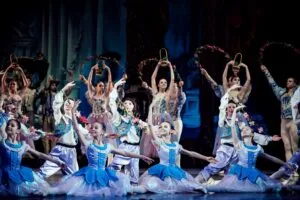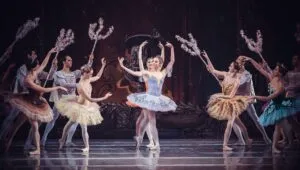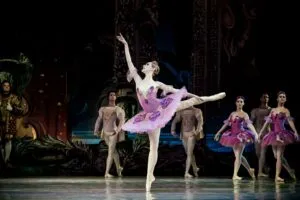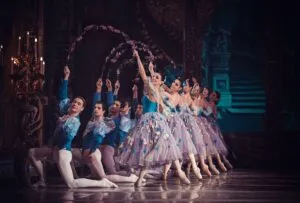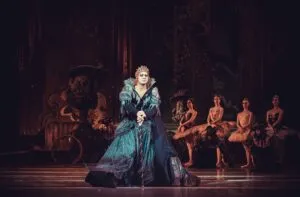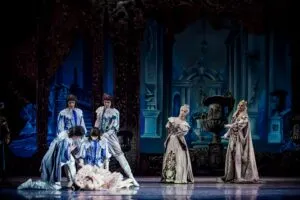Upcoming Events
History
The fairy tale of Sleeping Beauty is one of the most classic of stories that has been widely known for centuries. It has roots in European folklore, with one of the earliest known versions appearing in “Perceforest,” a medieval prose romance. The story became widely known through Charles Perrault’s version, titled “La Belle au bois dormant” (“The Beauty in the Sleeping Wood“), published in 1697. Perrault’s version is the one that most closely resembles the story as we know it today, with the elements of a cursed princess, a long sleep, and a prince’s kiss breaking the spell. The Brothers Grimm also included a version of the tale in their collection of fairy tales, titled “Dornröschen” (“Little Briar Rose“), further cementing the story’s place in European folklore.
The fairy tale was first adapted into a ballet by Ferdinand Hérold and Jean-Louis Aumer and was staged at the Paris Opéra on the 27th April 1829, with Lisa Noblet as the Princess Iseult and Marie Taglioni appearing in one scene as a naiad. Aumer and Hérold’s Sleeping Beauty was later staged in London on the 13th February 1833 at Drury Lane, with Pauline Duvernay as the Princess. The Sleeping Beauty was the first collaboration of Petipa and Peter Ilyich Tchaikovsky. Although Tchaikovsky’s first ballet Swan Lake had not been the success he had hoped for, it did not end his composition of ballets. Tchaikovsky was commissioned to compose the music for “The Sleeping Beauty” by Ivan Vsevolozhsky, the director of the Imperial Theatres in St. Petersburg, Russia. Vsevolozhsky wrote the libretto, basing it on both the original Perrault fairy tale and the Brothers Grimm version. Petipa wrote a very detailed list of instructions as to the musical requirements and Tchaikovsky worked quickly on the new work, he began initial sketches in the winter of 1888 and began orchestration work in May 1889.


“The Sleeping Beauty” premiered on January 15, 1890, at the Mariinsky Theatre in St. Petersburg and was an enormous success, one of Petipa’s biggest and Tchaikovsky’s most successful ballet. The role of Princess Aurora was danced by Carlotta Brianza, an Italian prima ballerina who was well-known in Europe. Prince Désiré was portrayed by Pavel Gerdt, one of the leading male dancers of the time. The Lilac Fairy was danced by the celebrated ballerina Maria Petipa, Marius Petipa’s daughter, and Carabosse was performed by Enrico Cecchetti, a legendary ballet master and pedagogue.

Prior to Petipa and Tchaikovsky’s version, there had been other ballet productions of The Sleeping Beauty in the west throughout the 19th century. The Petipa/Tchaikovsky version made its debut in the west in 1896 when it was staged by Giorgio Saracco at the Teatro alla Scala in Milan. Excerpts from the ballet were staged by Sergei Diaghilev in London in 1911, with Matilda Kschessinskaya as Princess Aurora and Vaslav Nijinsky as Prince Désiré. During the American tour from 1914 to 1920, Anna Pavlova and her company presented a forty-eight minute abridgment of “The Sleeping Beauty“, in which she danced Aurora. In 1921 “The Sleeping Beauty” was staged by Diaghilev for the Ballets Russes at the Alhambra Theatre in London under the title “The Sleeping Princess“. Dancing Princess Aurora and Prince Désiré in the première were Olga Spessivtseva and Pierre Vladimirov. The décor and costumes were designed by Leon Bakst. The following year, Diaghilev staged a one-act abridgement of the full-length ballet entitled “Aurora’s Wedding“, which was premièred at the Théâtre National de l’Opèra in Paris on the 18th May 1922, with Vera Trefilova as Princess Aurora and Pierre Vladimirov as Prince Désiré.
Dame Ninette De Valois staged the ballet under the same title as Diaghilev – “The Sleeping Princess” – and the production premièred on the 2nd February 1939 at the Sadler’s Wells Theatre in London, with Dame Margot Fonteyn as Princess Aurora and Sir Robert Helpmann as Prince Désiré. De Valois’s new production of “TheSleeping Beauty” premièred on the 20th February 1946, the date of the reopening of the Royal Opera House, with Margot Fonteyn as Princess Aurora, Robert Helpmann in the roles of both Prince Florimund and Carabosse and Dame Beryl Grey as the Lilac Fairy.
Frederick Ashton, one of the most influential choreographers in the history of ballet, created a significant production of “The Sleeping Beauty“ for The Royal Ballet in 1968. Ashton’s version for The Royal Ballet is celebrated for its elegance and technical brilliance. The production has become a defining interpretation of “Sleeping Beauty” in the English-speaking world. The pairing of Margot Fonteyn and Rudolf Nureyev in the original 1968 performances brought international acclaim and has become legendary. In 1981, George Balanchine choreographed and staged his own version of the Garland Waltz from the first act for New York City Ballet, under the title Garland Dance. In 1991, Balanchine’s successor Peter Martins staged his own production of The Sleeping Beauty for NYCB and inserted Balanchine’s Garland Dance into the first act.
In 2006, the Royal Ballet revived De Valois’s 1946 production, the revival premièred on the 15th May 2006, with Alina Cojocaru as Princess Aurora, Johan Kobborg as Prince Florimund, Marianela Nuñez as the Lilac Fairy and Genesia Rosato as Carabosse. In 2015, Alexei Ratmansky staged his own reconstruction of Petipa’s Sleeping Beauty with the Sergeyev Collection notations for American Ballet Theatre. This second reconstruction of The Sleeping Beauty was premièred in Orange County in March 2015, with Diana Vishneva as Princess Aurora, Marcello Gomes as Prince Désiré and Veronika Part as the Lilac Fairy, and was a renowned success. Ratmansky later staged his reconstruction at the Teatro alla Scala in Milan, where it premièred on the 30th September 2015, with Svetlana Zahkarova as Princess Aurora, Jacopi Tossi as Prince Désiré, Nicoletta Manni as the Lilac Fairy and Mick Zeni as Carabosse.
Synopsis
The ballet is divided into a prologue and three acts, with each section having a distinct storyline and musical themes.
Prologue: The Christening
- Setting: King Florestan’s palace
- Plot: The King and Queen celebrate the christening of their daughter, Princess Aurora. The court is filled with festivities, and six fairies are invited to bestow gifts upon the newborn princess. Each fairy offers a different gift, such as beauty, grace, musical talent, etc. However, the evil fairy Carabosse, who was not invited, arrives in anger and curses Aurora. She declares that on her sixteenth birthday, Aurora will prick her finger on a spindle and die. The Lilac Fairy, who is the most powerful, softens the curse. Instead of dying, Aurora will fall into a deep sleep for 100 years, only to be awakened by a prince’s kiss.
Act I: The Spell
- Setting: Aurora’s sixteenth birthday in the palace gardens
- Plot: The kingdom celebrates Aurora’s birthday, and four princes come to court her. During the celebrations, Aurora encounters an old woman (Carabosse in disguise) who gives her a spindle. Aurora pricks her finger and falls to the ground, fulfilling the curse. The Lilac Fairy appears and casts a spell, putting the entire kingdom to sleep until Aurora can be awakened by a prince.
Act II: The Vision
- Setting: 100 years later in a forest
- Plot: Prince Désiré is hunting in the forest when the Lilac Fairy appears and shows him a vision of Princess Aurora. Captivated by her beauty, the prince asks the Lilac Fairy to lead him to her. He battles Carabosse and her minions, eventually reaching the castle where Aurora lies asleep. The prince kisses Aurora, breaking the spell and waking the entire kingdom.
Act III: The Wedding
- Setting: The royal palace
- Plot: The ballet concludes with the grand wedding of Princess Aurora and Prince Désiré. The court and various fairy-tale characters (such as Cinderella, Puss in Boots, and others) attend the celebration. The act is filled with joyous dances, including the famous pas de deux between Aurora and the Prince. The ballet ends with a grand apotheosis celebrating the triumph of good over evil.
Why “The Sleeping Beauty” is called ballet-féerie?
“The Sleeping Beauty” is considered a quintessential example of a ballet- féerie, a genre of ballet that emphasizes magical and fantastical elements, often involving fairies, enchantments, and supernatural occurrences. The term “féerie” itself is derived from the French word for “fairy,” highlighting the genre’s focus on wonder, spectacle, and the supernatural. Here’s why “The Sleeping Beauty” fits this category:
1. Magical and Supernatural Themes
The storyline is deeply rooted in the realm of fantasy. It involves magical curses, enchanted sleep, and the intervention of fairies. The central plotrevolves around the curse placed on Princess Aurora by the evil fairy Carabosse and its eventual breaking by the Lilac Fairy and Prince Désiré.
2. Presence of Fairies
Fairies play a central role in the ballet, both as characters and in the overall narrative. The Prologue is dedicated to the gifts bestowed by the fairies on Aurora, and the Lilac Fairy serves as a guiding force throughout the story, representing the embodiment of good magic. Carabosse, the evil fairy, represents dark magic and serves as the antagonist.
3. Spectacular Visual and Choreographic Elements
“The Sleeping Beauty” is known for its opulent costumes, elaborate sets, and intricate choreography, all of which are hallmarks of the ballet-féerie genre. The ballet’s staging is designed to create a sense of wonder and fantasy, from the grandeur of the palace to the enchanted forest and the dazzling court scenes.
4. Enchanted Sleep and Awakening
The concept of a long, enchanted sleep and the magical awakening by true love’s kiss is a key fairy-tale trope. This magical sleep, lasting 100 years, is a perfect example of the kind of supernatural events typical of a ballet-féerie.
5. Inclusion of Fairy-Tale Characters
The ballet’s third act, “The Wedding,” features a gathering of various fairy-tale characters like Cinderella, Puss in Boots, and Little Red Riding Hood. This gathering of magical and mythical characters in one grand, celebratory event is typical of the spectacle and fantasy associated with the ballet-féerie genre.
6. Moral Themes and the Triumph of Good over Evil
The ballet-féerie often includes moral lessons, typically showcasing the triumph of good over evil through magical means. In “The Sleeping Beauty,” the Lilac Fairy’s goodness ultimately prevails over Carabosse’s malevolence, leading to a happy resolution that is both moral and magical.
7. Music Enhancing the Fantasy
Tchaikovsky’s score for “The Sleeping Beauty” is imbued with a sense of enchantment and grandeur, perfectly complementing the fantastical elements of the story. The music enhances the magical atmosphere, with themes that represent different characters and their magical attributes. Overall, “The Sleeping Beauty” embodies the essence of a ballet-féerie through its rich use of magical themes, fairies, fantastical settings, and a story that transports audiences into a world of enchantment and wonder.
Why “The Sleeping Beauty” is so popular in the world?
“The Sleeping Beauty” holds a special place in the world of ballet for several compelling reasons, contributing to its widespread popularity and enduring appeal:
1. Timeless Story
• Fairy Tale Appeal: Based on Charles Perrault’s classic fairy tale, “Sleeping Beauty” resonates with audiences through its enchanting narrative of magic, love, and redemption. The story’s universal themes of good versus evil and the triumph of true love have a timeless quality that captivates audiences of all ages.
• Rich Imagery: The ballet’s fairy tale setting allows for vivid and imaginative staging, with elaborate sets and costumes that transport audiences to a magical realm.
2. Exceptional Music
• Pyotr Ilyich Tchaikovsky’s Score: Tchaikovsky’s music for “Sleeping Beauty” is considered one of his greatest achievements. The score is renowned for its lush orchestration, memorable melodies, and intricate musical themes, enhancing the ballet’s emotional impact and appeal. The music supports the narrative and highlights the ballet’s various moods and scenes, making it a favourite among audiences and dancers alike.
3. Classic Choreography
• Marius Petipa’s Masterpiece: The original choreography by Marius Petipa is a cornerstone of classical ballet. Petipa’s intricate and grandiose choreography, including the famous “Rose Adagio” and various solo variations, showcases the technical prowess required in classical ballet and sets a high standard for performances.
• Signature Dance Sequences: The ballet features several iconic dance sequences and variations that have become central to classical ballet training and performance, such as the “Sleeping Beauty” Waltz, the “Dance of the Lilac Fairy,” and the “Pas de Deux”.
4. Elegant Staging
• Visual Splendor: The ballet’s elaborate sets and costumes, often reflecting a fairy-tale aesthetic, contribute to its visual appeal. The production values in “Sleeping Beauty” are typically high, with detailed designs that enhance the magical atmosphere of the story.
• Grandiose Presentation: The ballet’s grand scale and elaborate staging make it a spectacular experience for audiences, emphasizing its role as a centerpiece in classical ballet repertoires.
5. Technical and Artistic Challenge
• Showcase for Dancers: “Sleeping Beauty” offers a significant challenge for dancers, with its demanding choreography and multiple solo roles. It provides opportunities for ballerinas and danseurs to showcase their technical skill, artistry, and expressive abilities.
• Role for Principal Dancers: The principal roles of Princess Aurora and Prince Désiré are particularly coveted, allowing dancers to demonstrate theirvirtuosity and interpretive skills in leading roles.
6. Cultural and Historical Impact
• Influence on Ballet Tradition: Since its premiere in 1890, “Sleeping Beauty” has had a profound influence on the development of classical ballet. Itspreservation and adaptation by subsequent choreographers have contributed to its ongoing relevance and popularity in the ballet world.
• Global Reach: The ballet has been performed by major ballet companies around the world, each bringing its unique interpretation while preserving the core elements of Petipa’s choreography and Tchaikovsky’s music. This widespread performance history has helped cement its status as a global ballet classic.
7. Adaptability
• Various Interpretations: “The Sleeping Beauty” has been adapted and reinterpreted by numerous choreographers, each bringing their own vision to the ballet. From traditional to modern adaptations, these interpretations keep the ballet fresh and relevant for new generations.
• Educational Value: The ballet is often used in ballet schools and training programs as a standard example of classical ballet technique and storytelling, further ensuring its continued prominence. The popularity of “Sleeping Beauty” is a result of its enchanting story, Tchaikovsky’s memorable music, Petipa’s masterful choreography, and its grand visual presentation. It remains a beloved classic in the ballet repertoire, celebrated for its artistic and technical excellence, and continues to captivate audiences and inspire dancers worldwide.
Sources:

